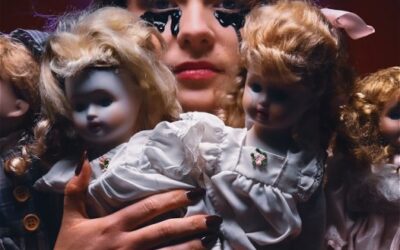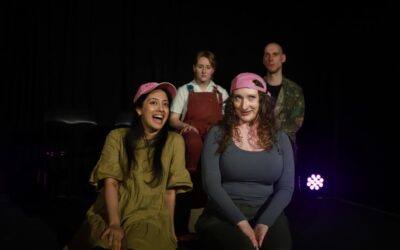By Darby Turnbull
Upon entering Meatmarket Stables for Last train to Madeline I was absolutely stunned by one of the most enchanting set designs I’ve seen in Indie theatre and certainly one of the best uses of the space I’ve seen. Rising star Savanna Wegman, already Green room nominated, and I hope many are in her future, design is a dreamy evocation of a concrete train station that finds the unexpected beauty in something banal and often ugly. It’s a space that allows for some deft staging from director Hayden Tonazzi that’s both playful and often poignant. Spencer Herd’s lighting design likewise bathes the space with stunning golden hues that filter memory and elegant use of shadows and rich blues.
If only my response to the standard of the production extended to the play itself. Callum Mackay’s text follows the connection of Maddy and Luke; two kids from Wangaratta through their childhood, adolescence and early adulthood; friendship, burgeoning love, estrangement and reconnection. On reading his notes in the program this topic is somewhat personal to Mackay and I’d be remiss if I didn’t mention that I spoke to a few people after the show who were complimentary about the piece.
Firstly, it’s a story I’ve seen played out many, many times especially amongst early career writers and it’s frustrating when a formula feels so diluted it loses its impact. This falls into a category ‘sensitive boy and the gorgeous, reckless girl who makes him suffer’ that I personally have little patience for. Maddy longs to escape the confines of her regional town and make it as a musician; she bears the scars of her father’s early exit from her life and her mother’s inability to care for her. Luke decides to stay and has existed in Maddy’s thrall his whole life despite not being as enigmatic and sees her flight as abandonment. Mackay’s text takes them through three timelines; ages 8, 17 and 23. Thankfully director Tonzanni elects to sign post their ages during scene transitions because there is very little shift in the dynamic or speech patterns between ages; they frequently use the same language and emotional insights at 8 that they do at 23. If this is a specific choice, perhaps to explore the fallibility of memory, it didn’t resonate with me.
Furthermore, their interactions lack texture or emotional weight; the play depends on these two having the kind of bond that leads the two back to each other’s orbits, but their scenes are repetitive and superficial. At its best the play offers a kind of time capsule to early 2000’s Australian culture that drew chuckles of delighted recognition from the audience but it’s not enough to add some essential specificity to these characters to make us care about them.
Luke, who stays is a crushing bore; at 8 he’s neurotic and shy and at 23 judgmental and pompous. He’s not a bore in the sense that he’s slightly provincial, doesn’t have the same grand ambitions as Maddy and stuck in a rut; it’s his (and the plays) lack of introspection. There’s definite potential to explore the toxicity of this relationship; he’s controlling and self-pitying who doesn’t take responsibility for his own role in conflict, but the play seems to take his side; it seems to want us to believe that he’s a ‘safe’, ‘solid’ foil to the flighty Maddy. Her ‘desertion’ that impacts him so hard seems to give him some entitlement to say some vile things to and about Maddy that isn’t challenged within the text, characters or production.
Maddy, like many manic pixie dream girls before her, is a collection of attributes rather than a fully fleshed out human; reckless, impetuous, wounded and a bit lost but irresistible. Again, there’s some real dramatic possibilities in an early life crisis, feeling like you’ve wasted your life when it’s only just beginning and inert to some of the ways you have grown because you feel stuck, but Mackay’s writing doesn’t explore it tangibly.
Luke at one point says that he’s ‘done changing himself’ for her Maddy but we don’t see any evidence of this beyond his willingness to comply with some of her risky behaviour. Maddy identity as a musician isn’t explored beyond some implausible developments; she’s apparently successful enough to get head hunted and a fully funded trip to London to record yet her musical career and development as an artist is murkily portrayed. Instead, the implication is that she’s living a destructive lifestyle compared to the ‘responsible’ Luke studying to be a nurse and a long-term girlfriend.
Neither feel grounded in any kind of emotional reality and so their conflict feels hollow and difficult to engage with.
Actors Ruby Maishman and Eddie Orton acquit themselves well even if they don’t transcend my reservations about the text. Maishman brings an impish petulance that develops from smart mouthed precocity as a child to brittle sarcasm as a young adult. Orton has some nice physical and verbal modulation in his own transitions between ages and exhibits some pointed insights into Luke’s self-loathing at his continued attraction to Maddy.
Tonazzi’s visual journey for Maddy and Luke is evoked with heart and humour with some lovely mis en scene especially in their childhood moments. A vulnerable moment has them framed in silhouette and I wish the text had explored the potential of games and play to make organic revelations about the characters’ internal lives rather than declaring them to us.
The team at Fever103 theatre evidently believe in this play strongly and the production values are a testament to their professionalism and commitment to high quality theatre. I hope that the feelings of catharsis and connection that the writer and director experienced in the development of this piece translate to their audience despite this not being for me.





